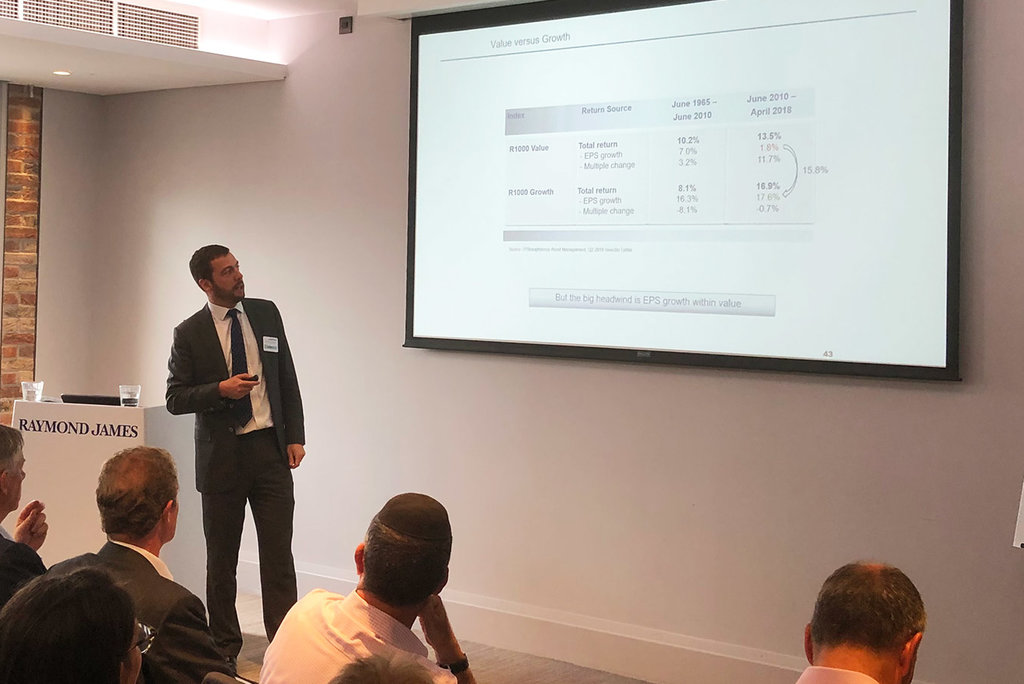At the Raymond James 2019 Professional Development Forum, which took place on 25 and 26 June 2019, Richard Garstang and Sam Ziff, co-managers of the Global Equity Income strategy discussed the concept of value investing and why they believe it works and will have its day again.
Please see below to read the Q&A with Richard and Sam.
Oldfield Partners: Why does value investing work over the long-term?
Q. Who are Oldfield Partners?
A. Oldfield Partners is a specialist value investment firm, managing circa £3billion of global value equity investments. We are a boutique investment manager based in Victoria, away from the noise and short-termism of the City. We are independent and owner managed, and we have significant co-investment in our strategies, aligning ourselves with our clients.
Q. What is your definition of value investing at Oldfield Partners?
A. As value investors, our approach is to invest in essentially sound but attractively valued companies – we search for companies and areas of the market that are out of favour and where sentiment is poor. We are looking for companies that are trading at prices well below our view of intrinsic value. This approach prevents being sucked into irrational exuberance. It provides a margin of safety. Our Global Equity Income portfolios are concentrated – typically 18-30 holdings - and we aim to generate an attractive income stream that grows over time. We are bottom up stock pickers but with a heavy value bias – and hence this strategy provides an ‘income with a difference’.
Q. What is the ‘difference’?
A. Firstly: We are an owner managed boutique and our interests are closely aligned with our clients. We run concentrated and contrarian portfolios with a very high active share – this is high conviction, truly active management. We offer an attractive and sustainable yield that can be re-invested or taken as a dividend but the key differentiator is the value bias of the portfolio – very few funds in the sector have this bias.
Q. There’s a lot of talk at the moment of the differences between value and growth – what does it mean to you?
A. Most analysts feel they must choose between two approaches customarily thought to be in opposition: “value” and “growth”. But we do not believe that value and growth are in complete opposition. We look to invest in companies when they are trading on attractive valuations, but this does not mean we completely ignore the prospects for earnings growth. As Warren Buffet suggested, the two approaches can be viewed as being joined at the hip.
Q. So you don’t believe in buying growth stocks, such as the FANGs?
A. We believe that picking high growth stocks, consistently and without overpaying, is difficult to do. It involves placing more emphasis on the future and predictions which are very difficult to get right, and hence the possibility for disappointment at the end of cycle is large and can lead to sharp falls in share prices. We would rather place more emphasis on current valuations and earnings power compared to history and compared to peers. Looking for companies at attractive valuations and trading at what we believe to be below their intrinsic value and hence offering a margin of safety.
Q. How do “value” and “growth” investors go about identifying potential investments?
A. Typically, the dividend yield and change in multiple (of earnings or cashflow, etc.) are part of the value approach, and unsurprisingly, EPS growth forms the basis for the growth approach. It does not mean that as value investors we eschew EPS growth entirely – we would like to have growth but we don’t want to overpay for it. Dividend yield is an important contributor to returns over time and, because we are buying attractively valued companies that are unloved or misunderstood by the market, they tend to be cheap in terms of multiple of earnings or cashflow, and this can play an important part in the return as the companies re-rate to higher multiples.
Q. So how do the two styles differ in terms of performance?
A. The total return of the S&P 500 from 1880 to 2014, a 134 year period, is 9% per annum. This return can be broken down between a 4.5% dividend yield and EPS growth of 4%, which combine to give a return of 8.5%. The final component of return – the change in multiple – contributed 0.3%. It is worth highlighting that the combined absolute return from these factors has been fairly consistent over time. And it’s also important to note that the return comes from both earnings growth and returning capital to shareholders.
Q. Why is this, and is it consistent over all time periods?
A. Over extremely long periods, the impact of rating changes tends to be diminished. Even big changes in the multiple are lost when annualised over so many years. However, even over investment periods of, say, 20 years, the starting multiple plays an important role in determining expected returns - it helps determine whether returns are likely to be above or below the long-run average. Research shows that a lower starting valuation has historically led to a significantly better subsequent 10 year return. So, valuation matters, and attractive valuations often arise when sentiment is poor. Therefore, being a contrarian and going against the herd is part of value investing. Of course, there are times when value doesn’t work - this includes the last 10 years - but, ultimately, starting valuations matter, and if you take the total return of the Russell 1000 Value and Growth Indices between 1965 and 2010, value outperformed growth over a 45 year period.
Q. So why will value outperform growth again, especially with the likes of the FANGs doing so well?
A. Fundamentally, it is about mean reversion and this is something that is present in many systems in financial and economic markets and beyond - and is also what makes growth investing so hard. For example, the profit margins of US companies have historically mean reverted. However, the last 30 years have seen strong growth and last year the average S&P company was around 11%. Google and Facebook margins are high by any standard, but Facebook at around 50% is reminiscent of a monopoly, and we would expect this to mean revert at some point. By way of reference, the average S&P 500 company has a margin around 11%. One driver for a change might be the share of GDP going to employees, which has been declining, and we are beginning to see a political response to this, which suggests a reversal could be coming.
Q. What example would you provide of a value investment?
A. Sometimes stocks can get too cheap, and become bargains. Our most recent investment was Allergan, the US healthcare company and owner of the Botox franchise. We purchased the company after the shares had fallen 50% over the previous three years and the valuation to under nine times earnings. The market had become frustrated with management and some of the short-term performance of the company. However, Allergan’s competitor, Abbvie, recognised this value and has offered to purchase the company for a 45% premium.
Q. So is it different this time?
A. To believe it is different this time – five of the most dangerous words in investing - you have to believe that mean reversion is dead, profits and cash flow don’t matter when valuing a company and ultimately that “trees will grow to the sky” – we simply don’t believe these to be true.




